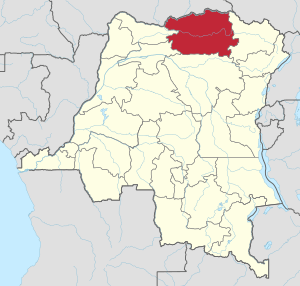Bas-Uélé facts for kids
Quick facts for kids
Bas-Uélé
|
||
|---|---|---|
|
Province
|
||
| Province du Bas-Uélé | ||
|
||
 |
||
| Country | ||
| Established | 2015 | |
| Named for | Uélé River | |
| Capital | Buta | |
| Area | ||
| • Total | 148,331 km2 (57,271 sq mi) | |
| Population
(2005 est.)
|
||
| • Total | 1,093,845 | |
| • Density | 7.374352/km2 (19.09948/sq mi) | |
| Time zone | UTC+2 (CAT) | |
| License Plate Code | ||
| Official language | French | |
| National language | Pa-Zande (Zande language) and Lingala | |
| Website | https://mobile.twitter.com/bas_uele | |
Bas-Uélé is a province in the Democratic Republic of the Congo. The name means "Lower Uélé" in French. It refers to the Uélé River that flows through the area.
Bas-Uélé is one of 21 new provinces created in 2015. These new provinces were formed when the larger Orientale Province was divided. The town of Buta became the capital city of this new province.
Where is Bas-Uélé?
Bas-Uélé is located in the northeast part of the Democratic Republic of the Congo. It gets its name from the Uélé River.
The province is divided into several smaller areas called territories. These territories help manage the different parts of the province.
- Aketi
- Ango
- Bambesa
- Bondo
- Buta
- Poko
Who Lives in Bas-Uélé?
In 2007, about 900,000 people lived in Bas-Uélé Province. Most of the people living here are from the Azandé people group.
Other groups also live in the province. These include the Boa, Bakere, Balele, Bakango, and Babenza people. Most people in Bas-Uélé make a living through farming and hunting. Some also trade goods along the rivers.
Ebola Outbreak
In 2017, the Democratic Republic of the Congo announced an Ebola outbreak in Bas-Uélé. Health officials worked quickly to stop the disease from spreading.
They tracked people who might have been in contact with the virus. They also tested blood samples to confirm cases. Monitoring people's health helped to control the situation.
See also
 In Spanish: Provincia de Bajo Uele para niños
In Spanish: Provincia de Bajo Uele para niños


